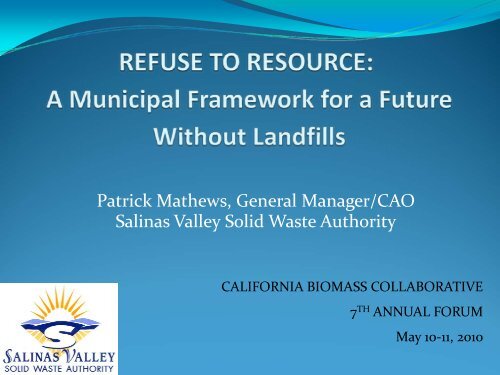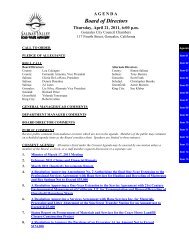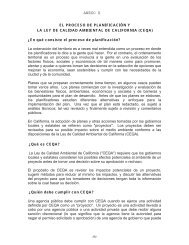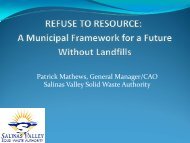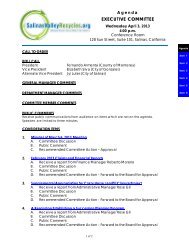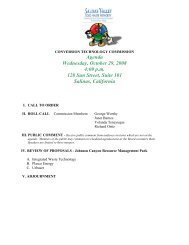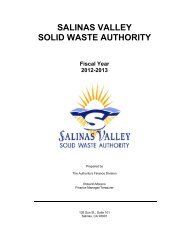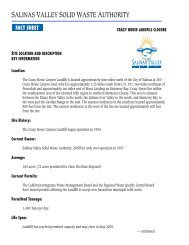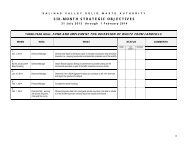Patrick Mathews, General Manager/CAO Salinas Valley Solid Waste ...
Patrick Mathews, General Manager/CAO Salinas Valley Solid Waste ...
Patrick Mathews, General Manager/CAO Salinas Valley Solid Waste ...
- No tags were found...
Create successful ePaper yourself
Turn your PDF publications into a flip-book with our unique Google optimized e-Paper software.
<strong>Salinas</strong> <strong>Valley</strong> <strong>Solid</strong> <strong>Waste</strong> Authority• Joint Powers Authority made up of five Cities + easternunincorporated Monterey County, CA• 260,000 ton per year waste stream• Goal 75% Diversion (by 2015) and 50 years of sustainableprocessing/ disposal capacity• Enthusiasm for conversion technologies (CT) grew fromopposition to new landfill studies in 2004• Study of CTs began in 2006 with formation of CTCommittee• CT decision will conclude this year
Mission/Vision/ValuesMissionTo manage <strong>Salinas</strong> <strong>Valley</strong> solid waste as a resource, promoting sustainable,environmentally sound and cost effective practices through an integratedsystem of waste reduction, reuse, recycling, innovative technology, customerservice and education.VisionTo reduce the amount of waste by promoting individual and corporateresponsibility.To recover waste for its highest and best use while balancing rates and services.To eliminate the need for landfills.To transform our business from burying waste to utilizing waste as a resource.ValuesInnovation • Integrity • Public Education • Efficiency • Fiscally PrudentResourcefulness • Customer Service • Community Partnerships
Where Do We Start? The <strong>Waste</strong>streamWASTESTREAMS1. Residential Garbage –“Wet/Low Value”2. Commercial Garbage –“Wet/Low Value”3. Commercial Garbage –“Dry/High Recovery”4. C&D –“High Recovery”5. Mixed Curbside Recyclables6. Source Separated Recyclables7. Greenwaste/Woodwaste/Foodwaste
How To Keep It Out Of The Landfill?The Easy OnesCommercial Garbage, “Dry” – Conventional MRFC&D – Conventional MRFMixed Curbside Recyclables – Conventional MRFSource Separated Recyclables – Facility ProgramsGreenwaste/Woodwaste/Foodwaste ‐Composting/Mulch Production
Where Do We Start? The <strong>Waste</strong>streamThe Hard Ones1. Residential Garbage –“Wet”2. Commercial Garbage –“Wet”3. Residue from the “Easy Ones”
What to Do With the Wet Stuff?• Autoclave Technology for Cellulose Recovery,Developed by Comprehensive Resources Recovery andReuse (CR3)• 60% of Residential and Commercial “Wet”<strong>Waste</strong>stream is Cellulose: 200‐300 TPD• Many market opportunities for cellulostic material• Simple Technology, extensively tested by USDA• Relatively low cost: $20‐$30/ton
Autoclave Testing Program2 year testing program• Partnership with USDA, CR3 and SVSWA• Environmental Impacts• Air, wastewater, noise and residue• Technological• O&M requirements• Downtime• Energy usage• Costs• Marketability of products• Ethanol Production (w/USDA)• Composting• Digestion (w/USDA)• Implementation Decision at the End of the Testing program
Autoclave Testing Program
Autoclave Testing Program
Autoclave Testing Program
Autoclave Testing Program
Autoclave Testing Program
Autoclave Testing Program
Autoclave Testing Program
Autoclave Testing Program
Autoclave Conclusions• Over 60% reduction in waste volume• Cellulose recovery• Ethanol production feedstock• Compost feedstock• Anaerobic digester feedstock for methane production• Paper Pulp w/additional washing process• Factual performance, emissions and cost information
MSW-based integrated biorefining system for the production of liquid biofuelsKevin M. Holtman, Diana Franqui-Espiet, David V. Bozzi, William J. Orts, Gregory M. GlennIntroduction• Municipal solid waste (MSW) is comprised of residential andcommercial refuse.• 250 million tons are produced annually in the U.S.• ~80 million tons of MSW are cellulosic wastes available forbiofuel production.Figure 1. Photos of autoclave operation from top left , a) MSW being loaded into autoclave; b)MSW in autoclave prior to processing; c) MSW after processing; d) Trommel screen;e) Pulp fiber after Trommel screen; f) Hydrocyclone cleaned pulp.Autoclaving MSW• Autoclaving uses only water and can be considered a “green”transformation process.• Pulp can be isolated after autoclaving by a simple rotary screen.(Table 1)• ~84 % of all organics in MSW are captured in the accepts bin.• Hazardous hand sorting of raw garbage is eliminated.• Hazardous “leachates” can be collected for disposal.• Landfill volume can be reduced as much as 80-90 %.IncomingMSW3/8”ScreenAccepts1”ScreenAcceptsOvers(> 1”)% pulp/paper 31.7 93.0 15.8 3.4% woody material 6.5 1.7 8.6 1.2% fines 4.5 1.9 1.4 0% plastic 15.5 1.3 21.9 36.0% glass 4.0 1.0 18.1 0% metal 3.6 0 3.6 14.0% C&D <strong>Waste</strong> 5.9 0.8 16.3 7.7% solid food waste 10.2 0 1.8 0.8% rubber/leather/textiles 17.4 0.4 12.5 36.9% total 99.3 100 100 100Table 1. Component breakdown of incoming garbage and streams separated by theTrommel screen.UntreatedMSWVOCs totreatment/disposalPolishedprocesswaterAutoclaveLarge wasteto landfillTrommelscreen1”acceptsGasificationRecyclablesMSWpulpProcess energy and steam/Electricity to gridPulpCleaningEnzymaticHydrolysis/FermentationUnreactedsolidsFWGlucosePolishedprocesswaterHeavyrejectsDistillationBottoms<strong>Solid</strong>sSeparationAqueousphaseAnaerobicDigestion/PolishingBiogas(CH 4 )Ethanol todistillationScheme 1. Simplified flow diagram for the MSW-based biorefinery. Model depicts theenergy sources produced by segregation of the different components of MSW.Integrated Biorefinery• An integrated biorefinery can divert virtually all organics from thelandfill.Excessto sewer• ~50 % of the cellulose in the pulp fraction can be converted toethanol without further pretreatment.• ~ 14 MM gal/yr of ethanol can be produced directly fromprocessing 3000 tpd MSW.• Remainder of organic fraction can be gasified to produceprocess steam/electricity and sell electricity back to the grid.• Food waste and other soluble organics are anaerobicallyfermented to methane.• Anaerobic digestion polishes process water for reuse.• Recyclables are readily collected and combustible wastesare gasified to produce energy.Aqueous pretreatment of MSW• Liquid hot water pretreatment and steam explosion are“green” technique and can improve hydrolysis yields to80-90 % of theoretical. (Figure 2)• Since no chemicals are used, these techniques arecompatible with the rest of the integrated biorefinery.• Pretreatment can increase the yield of ethanol to~30 MM gal/yr on a 3000 tpd basis.• Aqueous pretreatment can also improve the degreeof hydrolysis of wastes such as rice straw.% Conversion of glucose1008060402000 10 20 30 40 50 60 70 80Incubation time (h)195 C, 45 min 205 C, 10 min 215 C, 4 min 225 C, 0 minFigure 2. Optimal residence times at given temperatures provide maximum %conversion of available glucose for the unfractionated MSW.Economics• MSW provides economic justification for building a biorefinerydue to its good ROI and relatively small payback period.• MSW is produced year round and provides a realistic substratethe biorefinery.• Transportation costs are low because it is already collected.• MSW is produced near population centers and brought to acentral facility for processing.RevenueElectricity, $/yr $ 2,404,012Ethanol, $/yr $ 32,850,410Tipping fees for diversion, $/yr $ 34,783,636Recyclables, $/yr $ 313,727Total revenue, $/yr $ 70,351,786PROFITS, $/yr $ 49,717,624Economic IndicatorsNPV @ 10 % discount rate, $ $ 104,815,859IRR, % 16.2Annualized ROI, % 16.8Payback Period, yrs 5.8Table 2. Revenue flow and economic indicators for the 3000 tpd biorefinery.Incorporation of ag-waste• Ag-waste can be incorporated seasonally into an MSW-basedbiorefinery, alleviating the tight operating margins for atraditional biorefinery.• Cellulosics such as rice straw can be converted to ethanol ata 50-60 % efficiency.• Other ag-wastes such as spinach are largely solubilized in theautoclave and readily fermentable to methane.• Autoclaving serves as a perfect alternative for tainted orexpired food crops.
Partnership: SVSWA, USDA-ARS-Albany, CR 3 , & HDR/ Brown-VanceIntegrated, Flexible Biorefineriesfor Handling Municipal <strong>Solid</strong> <strong>Waste</strong>and Agricultural ResiduesArticulated vesselallows rapid loading& unloading andimproves mixingPaper, 36%Food scraps,12% Yard trimmings,12%Plastics, 11%Metals, 8%Others, 3%Rubber, leather,& textiles , 7%Wood, 6%Glass, 5%UntreatedMSWVOCs totreatment/disposalAutoclaveLarge wasteto landfillTrommelscreenRecyclablesFWMSWpulp PulpCleaningHeavyrejects1”acceptsEnzymaticHydrolysis/FermentationGlucoseDistillationEthanolPolishedprocesswaterAshto landfillGasificationUnreactedsolidsBottoms<strong>Solid</strong>sSeparationProcess energy and steam/Electricity to gridPolishedprocesswaterAqueousphaseAnaerobicDigestion/PolishingExcessto sewerBiogas(CH 4)ADDING VALUE TO ALL STREAMS: ProducingEthanol, Electricity, Methane, RecycledPaper, Recycled PlasticUC Davis DigesterUSDA-Agricultural Research ServiceWestern Reg. Research Center, Albany, CAFermentation to EthanolGasification EnergyDigestion MethaneKevin M. Holtman (kevin.holtman@ars.usda.gov)Diana Franqui-EspietDavid V. BozziGregory M. GlennWilliam J. Orts
• Autoclave TechnologyWhat’s Next?• Design/financing/procurement• CEQA• Permitting• Construction• Start‐up –2012?
What’s Left: Residues?The Hardest of the Hard Ones1. Residue from the “Hard Ones”2. Residue from the “Easy Ones”Metal, plastics, synthetics, some heavy fibers(unrecovered cardboard), lignens(unrecovered wood), inerts (soil, rocks)
What to Do With the Residue,“Except Landfilling”?• Incineration• Rocket to the Sun• Conversion Technologies?
What is a Conversion Technology?“A change in nature or form”•Gasification•Gasification with introduction of Plasma Field•Pyrolysis•Hydrolysis•Anaerobic Digestion•Many other options in various states of study
And the Winner is? Gasification• Use of heat, pressureand steam• Conversion to syngasthat can produceelectricity• Various processes:conventional, plasma,and pyrolysis
How to get Rid of a Landfill:THE PROCESS!RFP Goals• Maximum diversion• Materials separation/recovery• Reduce environmental impact• Financially self sustaining• Comparable gate fees• Public‐private partnership• Education center
What Do They Do?Vendor Responsibilities• Public outreach + education• Stakeholder meetings• Project development• CEQA and permitting• Financing• Construction• Operations
What Do We Do?Authority Responsibilities• Public outreach & education• Provide land• Dedicate tonnage• Establish rates• Ensure compliance• Construction oversight• Operations oversight• Utilize Education Center
What’s Next?Conversion Technology• Term Sheet negotiations with final two vendors• Final vendor selection Summer 2010• Contract development end of 2010• CEQA• Permitting• Construction• Start‐up –2014?
A FUTURE WITHOUT LANDFILLSWet GarbageRecyclablesGreen/Wood/FoodAutoclaveMRF/ProgramResidueCompostingResidueBiorefineryDigestionCompostingPulp WashingResidueMarketsGasificationAg MarketsGasificationBiomass FuelsEthanolMethane/FuelsElectricityAg MarketsPaper MillGasificationElectricityConst. ProductsElectricityConst. ProductsElectricityFuelElectricityConst. Products
For Further Information Contact:• <strong>Patrick</strong> <strong>Mathews</strong>, <strong>General</strong> <strong>Manager</strong>/<strong>CAO</strong><strong>Salinas</strong> <strong>Valley</strong> <strong>Solid</strong> <strong>Waste</strong> Authority128 Sun Street, Suite 101<strong>Salinas</strong>, CA 93901(831) 775‐3000


